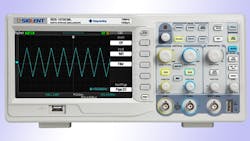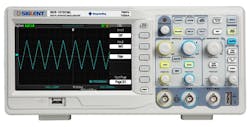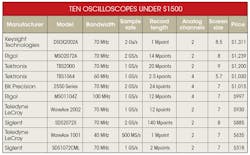You want to set up a testbench at home, so what can you get for $1500 or less in scopes these days? Quite a bit, as it turns out.
The question came up after chatting with Tektronix about its recently announced TBS2000 digital scope, and then again when chatting with a friend about a testbench he set up at home, as I’m looking to clear out space for my own. The combination was a clear signal to have a quick look at what is currently available for the home or small-office workbench.
This is by no means a comprehensive analysis of all the ins and outs of each of the 10 models listed—scope vendors are piling on features to get your attention in a highly contested end of the market. That’s good news for you as it means you get more for your money. This is simply a snapshot of what’s available at this moment in time.
Of course, there’s also the option to buy used equipment; even a 20- or 30-year-old analog scope will give excellent accuracy, signal resolution, and real-time response. Just be sure to calibrate it and allow for lots of room on your bench, which normally isn’t a problem given the potential savings.
There are many reasons to stick with ye olde scopes. Response time of digital scopes used to be one of them, but not anymore. Also, the newer digital storage and mixed-signal oscilloscopes, even at $1,500 or below, come with such a raft of connectivity (USB, LAN, Wi-Fi), software features, and built-in upgrade options that they are a slam dunk for the average engineering home user or hobbyist.
What Do You Really Need?
And therein lies the rub: With so many options and features, it becomes a case of having a really good idea of what your testing needs will be, and snapping up a good deal, direct from the manufacturer or from Amazon, which my friend did. His name is Craig Mathias, principal at the Farpoint Group, and he’s been “doing” wireless systems analysis for eons.
Now he’s interested in the audio band for some ideas he’s exploring. He ended up with a “budget-priced” $318 Siglent Technologies SDS1072CML 70-MHz, 7-in. TFT-LCD scope that he found on Amazon (see how this compares to the others in the table). He also picked up a Siglent SDG805 single-channel, 5-MHz signal generator, function generator, and arbitrary waveform generator, with a 125-MS/s sampling rate, for $270.
Good value, for very little cash down, “After all, these are really just A/D and D/A converters with a microprocessor and a display, so the real value is in the software,” said Craig. “Twenty years ago, functionality like this would have cost thousands!”
For him, the value also lay in the big, clear display as well as the ease of use. As hotly contested as this market is, with Tektronix and Rigol high on his list, he said that a little hands-on time with the Siglent at a local event pushed it over the top. You can’t beat face time for scopes; in addition to that big, sharp screen, it’s critical how the buttons, knobs, connectors, and sliders feel. Along with the multimeter, it’s our most personal of tools.
The Siglent replaced Craig’s 100-MHz. Hitachi V-509 scope with its tiny CRT. “I got used to doing scaling math in my head—good discipline, but error-prone and ultimately a waste of time, and the display was just too small.” It was time to move on.
The Rundown
Leaving out PC- or app-based instruments, the typical competitors in the budget space for scopes, along with Siglent, are Rigol, B&K Precision, and Tektronix. However, Teledyne LeCroy also has quite a few options between $635 and $1,500. PC-based scopes, such as those from PicoTech, have great features for the price, but you’ll always need a laptop next to you. We’ll focus on standalone for now.
The Tektronix TBS2000 line is the follow-on to the TBS1000 series. Starting at $1,200, it serves as a reference point for the others on the list only because it’s the most recently introduced. For that $1,200, you get a 70-MHz scope with a nice 9-in. screen, two analog channels, a record length of 20 Mpoints, a TekVPI probe interface, contextually aware help screens (great for newbies), 32 automated measurements, and courseware functions for educators. It also comes with one TPP0100 100-MHz, 10X passive probe per analog channel (I checked with the online sales chat line).
If you go up in price to $1,311, you can get the Keysight DSOX2002A, and for a whole lot less, you can get hold of a Teledyne LeCroy WaveAce 1001. Much depends on the application, so if you’re measuring sub-100-MHz signals and have $1,500 to spend, you’re in luck. Above 100 MHz, you can still get by, but you might not get 10X oversampling.
So, the requirements you’ve got include bandwidth, sampling rate, number of analog channels, number of digital channels (assuming mixed-signal capability), record length, and screen size. Next comes price.
But there are other things to consider:
• What is the supplier’s history and value as a low-cost scope provider?
• Are decent probes included or do you have to pay extra?
• Weight
• Are software upgrades available?
• Is the record length given per channel, or in aggregate?
• Warranty length
• Can you add functionality, like more bandwidth or even a waveform generator, by “unlocking” it after paying a credit-card charge?
• Wi-Fi support (new feature)?
Lots to consider, but these scopes have been out for some time (except for Tek’s TBS2000), so I’m thinking some folks have a few opinions to get first- (or fourth-) time buyers on the right track.
Above is the basic table. Maybe when we narrow it down, we can do a formal “bake off,” or even a simple review. In the meantime, what’s been your experience with any of these, and what would you recommend for under $1,500 (and have you managed to get your company to help pay for it)?
About the Author
Patrick Mannion Blog
Founder and Managing Director
Patrick Mannion is Founder and Managing Director of ClariTek, LLC, a high-tech editorial services company. After graduating with a National Diploma in Electronic Engineering from the Dundalk Institute of Technology, he worked for three years in the industry before starting a career in b2b media and events. He has been covering the engineering, technology, design, and the electronics industry for 25 years. His various roles included Components and Communications Editor at Electronic Design and more recently Brand Director for UBM's Electronics media, including EDN, EETimes, Embedded.com, and TechOnline.



